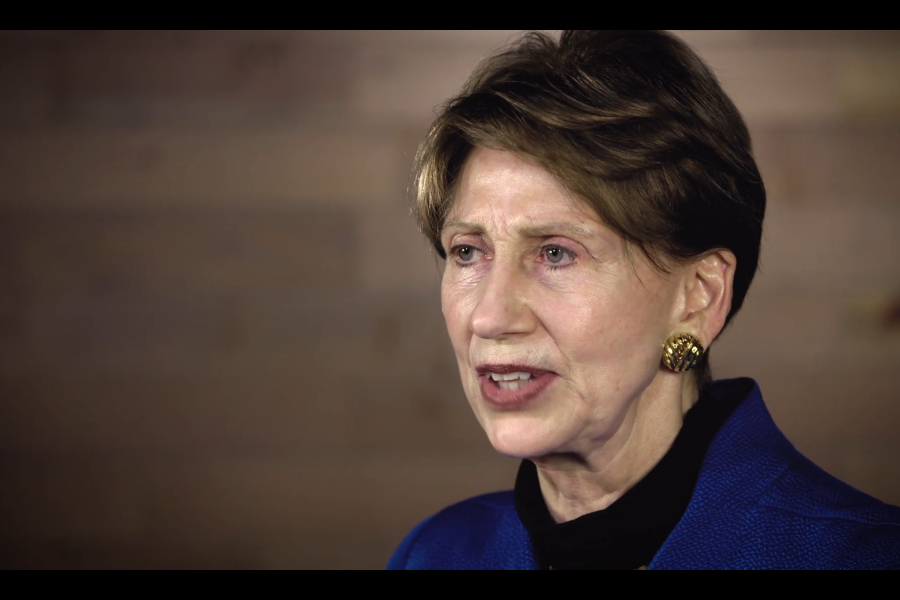For nearly 80 years, experimental X-planes have been the marker of cutting-edge aerospace technology. Now, the digital age is ushering in a new kind of aircraft: the eSeries.
The Air Force and Space Force will begin adding “e” to the names of aircraft, weapons, and satellites that are designed and tested using digital engineering, Air Force Secretary Barbara M. Barrett said Sept. 14 at the Air Force Association’s virtual Air, Space & Cyber Conference.
“For 73 years, the entire history of the Air Force, X-planes have represented technological innovation,” Barrett said. “Today, the e-plane and e-sat will join them in making history and ensuring Airmen and space professionals have modern tools to protect our nation.”
Digital engineering uses advanced computer modeling and simulation, and technology like virtual and augmented reality, to quickly draw up hardware blueprints and vet how various configurations would work in the real world without building a physical prototype. Modern digital engineering is more accurate and reliable than the computer-assisted development of the past, and proponents say it cuts costs as well.
The military is betting that classifying assets in a new way to reflect changes in development and manufacturing will inspire the defense industry to adopt those techniques.
“The service acquisition executive will determine whether an acquisition program meets the digital acquisition threshold,” Air Force spokeswoman Ann Stefanek said. If a system qualifies for the ‘e’ in development, it will drop the designation when it begins production.
Aircraft like the EA-18G Growler and E-8C Joint STARS use an uppercase E to name planes that are modified with electronic devices for electronic warfare, airborne early warning radar, and airborne command and control missions, as well as tactical data communications links for manned flight.
Boeing’s Red Hawk trainer jet is the first plane to earn an “e” designation, as the eT-7A.
“Can something fly thousands of hours before it takes off, be laid out and assembled hundreds of times before any metal is even cut?” the Air Force said in a video about the Red Hawk. “Can something be designed, built, and tested, not by thousands of people, but by fewer than 200, using leading-edge design tools across a digital landscape, connected virtually across the globe? It can. It was.”
Named for the red-tailed aircraft flown by the Tuskegee Airmen in World War II as well as the Curtiss P-40 Warhawk fighter plane, the $9.2 billion eT-7A jet will serve as the training platform for the F-35 Joint Strike Fighter and other advanced aircraft.
The first of at least 351 Red Hawks is slated for delivery in 2023, five years after Boeing won a $9.2 billion contract to build the program’s planes, simulators, and other equipment. The company argues digital engineering has made the development process more effective and efficient.
“New 3D modeling software meant the company could create a digital twin, test performance in virtual wind tunnels, and make adjustments rapidly, without having to bend metal,” Air Force Magazine reported in June 2019.
Air Force acquisition boss Will Roper has pushed the service to embrace digital engineering as a way of adapting to emerging threats and adding in promising upgrades. Roper’s “Digital Century Series” idea—a plan to come up with new aircraft designs every few years and build them in small batches—relies on speedy engineering techniques.
Digital engineering “brings a high level of fidelity, and not just in the design of the aircraft,” he told Air Force Magazine last year.
“It’s the assembly line, where people are doing work; what work is being done; the machines that do the work; the tooling. All digitally modeled, so you can optimize it,” he said. “You can get expensive tooling out if you can find a better substitute. You can change a process from requiring an artisan with years of training to one requiring a lower skill level.”
Other ongoing programs like the Ground-Based Strategic Deterrent, which the service often touts as a model for future research and development, could see the “e” designation as well.
In her first speech at AFA’s major annual conference since becoming secretary last November, Barrett also touted the Air Force’s top four priorities for the coming year: maturing the Space Force, strengthening ties with allied and partner countries, supporting military personnel and their families, and modernizing the inventory.
“Our air and space professionals, and the families who stand by them, are our greatest asset and our future,” she said. “We are committed to cultivating a culture of trust, respect, and inclusivity, and developing leaders to overcome the demands of the future.”

